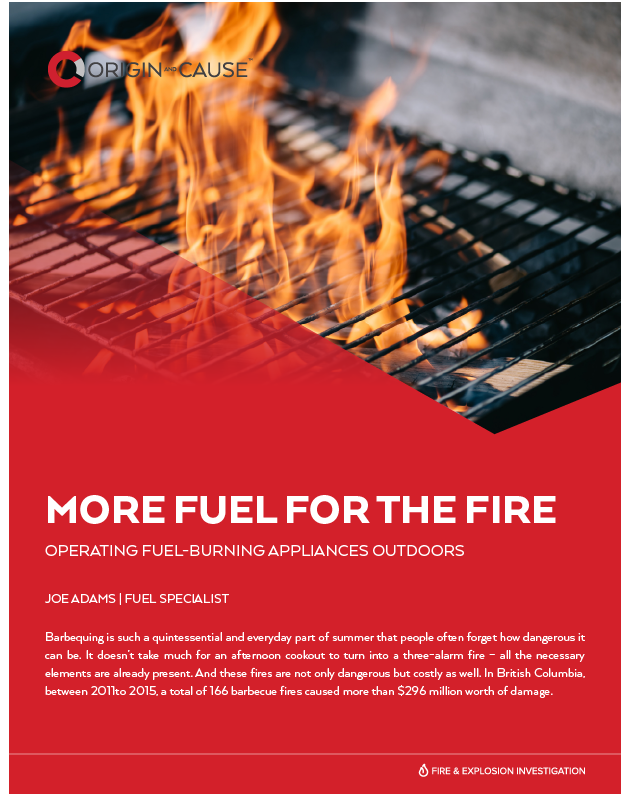Article Post
More Fuel for the Fire: Operating Fuel-burning Appliances Outdoors
July 15, 2019 | By: Joe Adams

Common Causes of Barbecue Fires
The three most common causes of barbecue fires are:
- Failure to clean
- Leaving a barbecue unattended
- Operating a barbecue too close to something combustible
All three of these causes are user-related and easily preventable. They also all have the potential to cause considerable damage and injury. However, for this article, I am going to focus on operating a barbecue too close to combustibles.
Clearance from Combustibles
Operating a barbecue at a safe distance from combustibles is more than just a practical tip; appropriate operating distances are stated in the barbecue instruction manual, on the manufacturer’s rating plate, as well as in many local by-laws.
In St. Catharines, for example, the Open Air Burning By-Law (section 6.1.2.) states that a person may operate a barbecue provided that:
(i) the Cooking Fire is located not less than 1 metre horizontally from any structure, overhang or balcony, property line, tree, fence, roadway, overhead wires or other combustible material.
(ii) the surface of the Cooking Fire is located not less than 3 metres below any overhead objects;
(iii) the Cooking Fire is located not less than 3 metres from all building openings and intakes;
While there are numerous examples of people barbecuing in front of patio doors, and under all manner of awnings, pergolas and gazebos, what I come across most often is barbecuing too close to a structure, fence, combustible, etc. How many times have you been in someone’s backyard for a barbecue where the grill was more than 1 metre away from the house, fence or deck railing? It would seem to be the exception rather than the rule. But while it may often be overlooked, it’s importance can’t be overemphasized. In my experience with structural fires that originate from barbecues, it’s the vinyl siding that catches first. Once that happens, regardless of the cause, it’s very difficult to put out and it can spread to the rest of the house quite efficiently. Which is why, in the event of a fire, it is important to determine where the barbecue was when the fire started (oftentimes the barbecue is moved by the fire department during fire suppression).
The position of the barbecue becomes even more important should the dwelling be a rental property. If a tenant was barbecuing, the first consideration should be, were they allowed to operate a fuel-burning cooking appliance? If not, who provided the barbecue, the tenant or the landlord? Also, was it being operated properly – as set out in the manual – and in compliance with local by-laws? All of these questions are important in the event of a liability suit.
Hose Failures
There are, of course, times when a barbecue fire occurs in the absence of any kind of mistake or oversight on the part of the user. According to the National Fire Protection Association, after failure to clean, leaving the barbecue unattended, and having it too close to combustibles, leaks or breaks are cited as the primary cause of barbecue fires. Most of the investigations that I have undertaken, where the barbecue itself proved to be the problem, involved hose failures of one kind or another. Over time, hoses can crack and leak, as can the plastic connectors that attach to the propane tank. There’s a reason why manufacturers and fire departments stress the importance of checking for leaks. This should be done at the beginning of the season and when connecting a new propane tank: Turn on the gas (without turning on the barbecue) and spray the valve, regulator and hose assembly with the soapy water. If there is a leak, bubbles will form over the affected area. However, hoses can also fail as a result of a manufacturing defect.
Manufacturing Defects
In one case, a defect for which the barbecue was later recalled, exposed the fuel hose to extremely high temperatures. Eventually, the hose separated from the burner manifold. This already-dangerous situation was compounded by the fact that the barbecue was right up against the house. The next time the barbecue was lit, it flared up and was soon out of control. The vinyl siding ignited first and then spread to the roof and attic. The resulting damage was in the hundreds of thousands of dollars, caused in part by a failure to take the proper precautions.
Questions to Ask Insureds
- How old is the barbecue?
- Where was it purchased?
- Do you have the manual and receipt?
An additional question, although not strictly related to recalls, is, when was it last serviced? Most people may be completely unaware that a barbecue needs to be serviced, but if it was serviced by a licensed gas fitter, that could open up another avenue for subrogation.
Homeowner Tip
Always turn your barbecue off as soon as you finish using it – both the burners and the propane or natural gas. It’s far too easy to walk away and forget, leaving your barbecue to overheat. In extreme cases, where they have been left on for several days, I have seen barbecues turn into blobs of white metal, collapse, and ignite surrounding combustibles inside and outside the clearance zone.
Nothing says summer quite like a barbecue, but there are inherent dangers in operating any fuel-burning appliance, and every year we witness the consequences and costs of failures, defects, improper maintenance and assembly, and user error. While assigning responsibility can become a complicated matter with so many variables, a forensic investigation, led by experienced professions, can assist in determining the root cause.

Download |
Accepted as an expert witness in all levels of criminal and civil courts, Joseph specializes in natural gas and propane fuelled fires and explosions. He has completed over 500 natural gas leak investigations and more than 200 fire and explosion investigations.